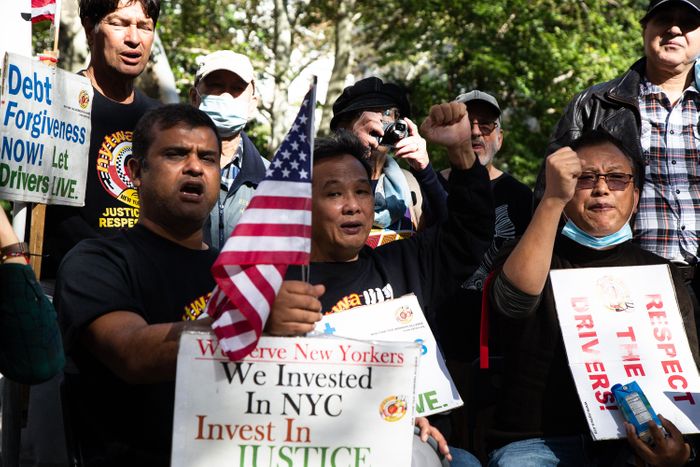
In 2006, when Richard Chow bought his taxi medallion from the city for $410,000, it seemed like a great idea. The value of medallions was rising steadily and the Taxi and Limousine Commission was touting them as good long-term investments, so he took out a $358,200 loan. Then came the disruption — Uber, Lyft — and a collapse in the market in 2014. Chow, like thousands of other predominantly immigrant drivers, was left with a medallion he could only resell for perhaps a quarter of its former value, $389,000 in debt, and no hope of retiring. His case isn’t even the worst; the average medallion debt is now $500,000, according to the New York Taxi Workers Alliance, and the ongoing crisis has led nine of its members to take their own lives — including Chow’s brother, Kenny, who died by suicide in 2018. It was the loss of his brother that led him to join at least 10 other drivers in a hunger strike that started yesterday outside City Hall. Drivers have already been protesting there for more than a month to push de Blasio to overhaul the city’s rescue plan for drivers before he leaves office. Now Chow and the others say they will not eat or leave their sidewalk post until de Blasio agrees to two demands: that the city become the guarantor for all medallion debt and set lower monthly payments to lenders.
“The mayor and the city have neglected us,” Chow told Curbed yesterday. “They’re only helping the lenders, the banks and credit unions, while they lead us to bankruptcy and suicide.” The striking drivers sit in chairs set up on the sidewalk in front of a banner that reads “Hunger Strike, #EndCabbieDeath.” At night, some striking drivers sleep in their cars, and others in a rented van. Nearby there’s also a memorial for the drivers who have died by suicide since 2018, with fresh flowers and red candles surrounding a list of their names.
The ongoing protest and hunger strike are a clear signal from the 6,000 medallion owner-drivers that the city’s $65 million fund to alleviate drivers’ debt, which was announced back in March, is wholly inadequate. The relief plan, funded by the federal stimulus, offers $20,000 and $9,000 grants to use as a down payment for restructuring their debt. (And as of October 16, just 21 drivers have settled their debt through this program, according to the TLC.) But the plan, which allows lenders to require monthly payments up to $2,000, could leave many drivers with as little as $7/hour in wages, says the NYTWA. Some drivers who have qualified for relief are now paying up to $1,700 a month. The union also opposes the fact that drivers are personally responsible if a loan is foreclosed on. The NYTWA offered up a plan of its own which would have the city guarantee the drivers’ debt and cap payments at $800. This plan has support from Comptroller Scott Stringer, Attorney General Tish James, and Senate Majority Leader Chuck Schumer. But Mayor de Blasio says the city can’t afford it.
The striking drivers, most of whom are around 50 years old, will be monitored by doctors twice a day while they go without food. Zahid Islam, a striking 42-year-old driver from Bangladesh who owes around $800,000 for his medallion, has high blood pressure and high cholesterol and is pre-diabetic, but he says he’s still determined to help drivers get some relief. “I don’t know what will happen to me,” he says. “But I am joining the hunger strike because we have to fix it, because nobody’s listening to us.”
"strike" - Google News
October 22, 2021 at 07:27AM
https://ift.tt/2XDoqr4
The Medallion Crisis Is So Bad that Taxi Drivers Are on a Hunger Strike - Curbed
"strike" - Google News
https://ift.tt/2WheuPk
https://ift.tt/2VWImBB
Bagikan Berita Ini















0 Response to "The Medallion Crisis Is So Bad that Taxi Drivers Are on a Hunger Strike - Curbed"
Post a Comment